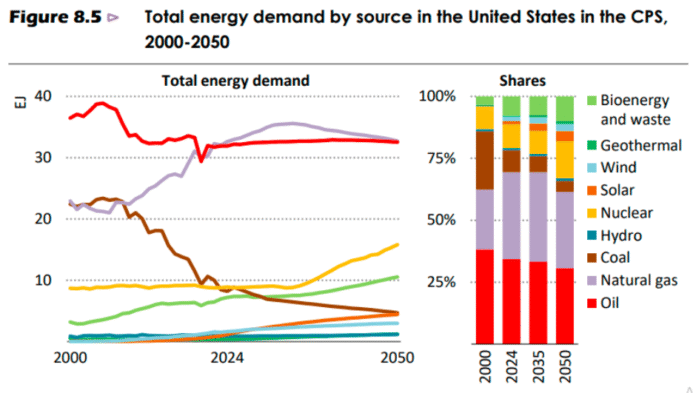The World Energy Outlook 2025 presents a detailed picture of the evolving energy landscape in the United States. The passage of the One Big Beautiful Bill Act (OBBBA) in 2025 marks a major policy shift, focusing on boosting domestic production, strengthening energy security, and supporting low-emission technologies. The following ten key points from the IEA report summarize the main trends shaping the US energy outlook through 2035.
1. The One Big Beautiful Bill Act Reshapes US Energy Policy
The OBBBA rebalances federal support across energy sectors, promoting coal, oil, gas, nuclear, and geothermal energy. It mandates new leasing for oil and gas, restores drilling tax deductions, and extends credits for carbon capture, nuclear, and storage technologies while phasing out incentives for wind, solar, and electric vehicles.
2. Energy Demand Returns to Growth
After two decades of flat demand, total US energy consumption is projected to rise by 0.5 percent annually to 2035 under the Current Policies Scenario (CPS). Natural gas leads this growth, remaining the largest energy source through 2050, while oil demand plateaus and coal continues to decline.
3. Natural Gas Dominates the Energy Mix
The United States remains the world’s largest natural gas producer and exporter. Gas meets rising domestic and industrial demand, particularly from data centers and power generation, and strengthens the country’s position in global energy markets.
4. Oil Production Growth Outpaces Domestic Demand
US oil output increases by around 0.1 million barrels per day each year to 2035, outpacing domestic demand and expanding net exports by nearly 0.5 million barrels per day. The United States retains its status as the world’s largest oil producer.
5. Nuclear Power Poised for a Major Comeback
Supported by strong policy incentives under the OBBBA, nuclear capacity remains stable through 2030 and then rises by one-third by 2040 and over 80 percent by 2050. Small modular reactors (SMRs) and large-scale projects drive this resurgence, backed by private investment and federal financing.
6. Renewables Continue Expanding Despite Reduced Incentives
Even as federal tax credits for wind and solar phase out, renewable capacity increases by two-thirds by 2035. Geothermal energy grows by 75 percent, supported by accelerated permitting, while bioenergy remains the largest renewable source through 2050.
7. Transport Sector Still Reliant on Oil
Oil continues to dominate the transport sector, meeting more than 80 percent of total demand through 2050. EV adoption slows as federal incentives decline, although state-level policies and infrastructure investments sustain gradual growth.
8. Power Sector Shifts Toward Gas and Low-Emission Technologies
Natural gas remains the leading source of electricity generation to 2050, but the share of low-emission sources – including nuclear, geothermal, and bioenergy – rises steadily. State-level renewable mandates under the Stated Policies Scenario (STEPS) further diversify the power mix.
9. Industrial and Building Sectors Drive New Demand
In industry, natural gas meets about half of new energy demand, while electricity and oil also increase. In buildings, electricity continues to replace oil use, and gas remains stable. The growing digital economy – including data centers – becomes a new demand driver for natural gas.
10. United States Strengthens Global Energy Leadership
The US remains the world’s largest producer and consumer of both oil and gas, a top nuclear operator, and the second-largest generator of renewable power. Expanding exports of LNG and refined products reinforce its influence over global energy security and trade dynamics.
Conclusion
The World Energy Outlook 2025 highlights the United States’ transition toward a more diversified yet domestically focused energy system. The OBBBA has revitalized traditional energy industries while sustaining investment in nuclear and geothermal technologies. Despite slower renewable growth, the US continues to lead in global production, innovation, and energy security.
Baburajan Kizhakedath

